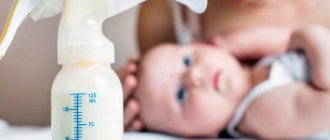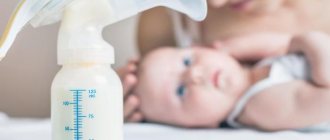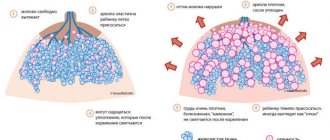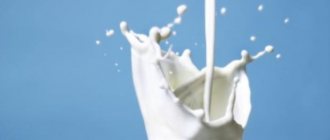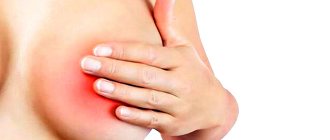Breastfeeding mothers are concerned with the important question of how to stop breast milk lactation so that it happens without unnecessary worry and discomfort for the baby, and no damage is caused to the baby’s health. Therefore, this must be done competently. It is recommended that before stopping lactation completely, you seek advice from an experienced specialist.
Basic principles of breastfeeding
The duration of breastfeeding is not an arbitrary decision of the mother, but certain physiological criteria that follow each other and are intertwined.
In other words, the duration of breastfeeding should be determined by the natural needs of the child, which fade away over time, giving way to new ones. It is generally accepted that breastfeeding should last at least six months, and then it is allowed to replace it with formula milk and the introduction of new products. Six months is too short a period to stop lactation, since the sucking reflex in a child fades away only by the age of two, and in some children by three. All this suggests that natural feeding should continue for at least two years.
There are many reasons why a breastfeeding woman wants to stop breastfeeding, for example:
- The child is more than two years old.
- The need to go to work.
- New pregnancy.
- Fatigue from breastfeeding.
- Maternal illness requiring drug treatment incompatible with lactation.
There may be thousands of other reasons pushing a woman to take this important step, but she must be aware that stopping lactation means depriving the baby of breast milk forever. Therefore, if mommy feels doubts and uncertainty, then it is better to postpone this moment to a later date.
To prevent lactation from decreasing, several basic principles of feeding should be followed:
- Within an hour after birth, the baby should be attached to the breast. This stimulates the production of colostrum and then milk.
- The baby should latch onto the breast correctly.
It is very important to teach him this. In one of the video lessons of the “Breastfeeding Secrets” course, you will learn how to properly breastfeed your baby and learn comfortable feeding positions.
If breast latch is not corrected, this will lead to poor breast stimulation, abrasions and cracks.
As a result, feeding will be painful. How to deal with cracks, read the article: Cracks in the nipples during feeding.
For a small child, a regimen is not needed. Put the clock in the far corner of the room, and apply the baby at his request. Frequent breastfeeding in the correct position helps increase milk production.
- The baby knows perfectly well how much milk he needs and when he is full. Therefore, do not limit feeding to a time frame.
- You should not refuse to put your baby to your breast at night. This allows you to increase lactation. Try to feed at least 3-4 times at night.
- It is not recommended to bottle feed your baby. The baby may refuse to breastfeed altogether. After all, sucking milk from it is more difficult than from a bottle.
These are the most important principles from which to start increasing breast milk production.
Remember how a house is built: first we lay a strong, solid, reliable foundation, and then build a beautiful house on it.
So it is here: you can increase the amount of breast milk by following the above breastfeeding rules. In addition, study the video course “Secrets of Breastfeeding” so that your milk comes in and your baby has enough of it.
It is important for a nursing woman to monitor her child for allergic reactions to certain foods. After a month, something new should be introduced into the mother’s daily menu gradually. Products can be divided into 3 groups, among which there are high, medium and low allergens. A nursing woman's diet should not contain highly allergenic foods.
During breastfeeding, the foundations for a child's health are laid. During this period, mothers need to try to preserve milk, and, if necessary, increase lactation. To achieve this, a woman’s diet is expanded with special foods, drinks and cocktails that do not cause allergic reactions.
When to stop lactation
Sooner or later there comes a time when it is necessary to stop lactation. Some doctors recommend doing this no earlier than six months and no later than a year after giving birth. It is generally accepted that the sooner a decision is made, the easier it will be to wean a child from breastfeeding.
However, if lactation stops early, the baby may experience severe stress. In addition, a child’s immunity begins to develop only at 10-12 months. Until this time, mother's milk acts as a kind of protection for the baby's body from the influence of various pathogenic microorganisms. Accordingly, early cessation of breastfeeding can negatively affect the child's health.
Other experts recommend breastfeeding until the child is 2-3 years old. However, a two-year-old child asking his mother for a breast in a store or other public place attracts puzzled looks from others.
It is worth noting that breast milk loses its beneficial properties after about 1.5 years after the start of feeding. Therefore, it is more advisable to stop lactation during this period, when the child turns 1.5-2 years old.
What to do if a nursing mother’s milk disappears early. Special formulas containing a milk composition can replace breast milk. You can also feed your baby cow's milk, which is rich in beneficial microelements and vitamins.
Drinking regime
Products that increase lactation in the first days after childbirth and beyond are primarily liquid (milk, juices, teas, water). Many young mothers are convinced that there should be as much fluid as possible, this stimulates milk production. This is partly true, but the quality of this baby’s main dish will be significantly worse. Excess water has a diluting effect on milk, depriving it of valuable vitamins, minerals, fat and protein.
The mammary glands produce approximately 800-900 ml of milk per day. To “support” their work, it is enough to consume about 2 liters of liquid per day. You should take into account not only drinks, but all liquid foods (for example, soups).
Herbal infusions, teas
When choosing products that increase lactation in women, we must not forget about healing herbal teas, mixtures, and infusions. There are three groups of herbs that not only “encourage” milk production, but also solve certain health problems.
- Nettle. It is useful for physical exhaustion, chronic weakness, low hemoglobin, and anemia.
- Melissa, mint and oregano. These herbs perfectly relieve stress and tension, which often have a negative effect on lactation processes.
- Dill, fennel and cumin. Teas based on these herbs effectively solve problems associated with the digestive tract.
The number one recipe for solving problems with milk, proven over centuries, is a decoction made from dill seeds. 1 tbsp. l. seeds are poured with a glass of boiling water, infused for 1.5-2 hours, cooled. It is enough to drink half a glass twice a day. Alternatives to dill that produce the same effect are anise, caraway.
Important information
There is a misconception that to completely stop the production of breast milk, you should wrap your breasts with a bandage or thick cloth. These actions can disrupt a woman’s hormonal levels, disrupt the menstrual cycle and develop various diseases, such as mastitis.
Thus, it is best to reduce or stop breast milk lactation when the child is 1.5-2 years old. As a rule, at this age this can be done naturally. To reduce the production of breast milk, there are other ways, for example, special compresses and tinctures made from natural ingredients.
Basic Rules
To provide a newborn with a sufficient amount of mother's milk, a nursing woman must adhere to basic nutritional conditions at home.1. Eliminate the following foods from your diet:
- alcoholic and carbonated drinks;
- coffee and strong tea;
- chocolate products;
- any canned food;
- meat or fish without special heat treatment - sushi, ram, dried meat, kebabs;
- seafood - shrimp, mussels, crabs;
- unpasteurized milk, hard cheese, sour cream;
- smoked meats;
- mayonnaise and sauces with seasonings;
- hard-boiled eggs.
2. Eat dishes that enrich milk with vitamins and microelements that stimulate its production. These include:
- buckwheat or oatmeal with fruit;
- raw and boiled vegetables - onions, radishes, carrots, pumpkin;
- nuts – pine, walnuts and almonds; some experts recommend eating only a few kernels per day of one type of nut;
- waste products of bees - honey, royal jelly;
- black currant;
- nut milk – 2 tbsp. l. walnuts pour boiling milk in a thermos, take 1 tbsp. l. several times a day and monitor the baby’s reaction.
3. Stick to your drinking regime. You need to drink at least one and a half liters of liquid per day. However, milk soups or drinks are considered food and not drink. Lactation is enhanced by certain herbal decoctions or juices:
- green tea;
- fresh juices;
- dried fruit compote, or fresh fruit compote;
- fruit drinks from black currants, blueberries;
- herbal teas - from anise, cumin, oregano, dill, fennel, thyme, nettle;
- Dill water.
It is recommended to drink the drink warm about half an hour before feeding the baby. If it is difficult to drink such an amount of liquid, then you need to drink just one cup more than usual. This will be enough to increase lactation. If some foods were not previously familiar to you, introduce them into your diet one at a time to avoid your reaction or your baby’s possible allergies.
In order not to harm either yourself or the baby, you need to know how to stop lactation naturally correctly. There are several basic rules for stopping breastfeeding. By following them, the woman painlessly moves on to a new stage of feeding the child.
If the baby is over one year old and already eats adult food, then the best option would be to gradually replace breastfeeding with another liquid. You can offer your baby baby juices, compotes, baby teas or plain water. In a situation where the baby refuses to take anything other than his mother's breast, he should be given a bottle of formula.
After replacing all daytime feedings with another liquid, night feedings remain. In just a few weeks, you can wean your baby off nighttime latching by replacing the breast with a pacifier or bottle.
Such a gradual decrease in lactation will save the child from psychological trauma, and the mother from mastitis and other problems with the mammary glands.
Drinks, juices
There are other ways to increase lactation. They cannot be classified as basic, but nevertheless they can provide temporary assistance to the body.
Start monitoring your drinking regime, drink at least two liters of liquid during the day. In this case, you should not take into account dairy soups and drinks. It is best to drink water or tea. So, how to increase lactation for a nursing mother with the help of drinks? Start drinking more drinks such as:
- green tea;
- compote made from fresh or dried fruits;
- tea made from herbs that increase lactation (anise, cumin, oregano, dill, and so on);
- fresh juices;
- carrot infusion;
- oatmeal broth;
- nut milk;
- blueberry or black currant juice.
Dill water is considered no less useful. This drink helps stimulate lactation and helps relieve constipation in the baby. All drinks must be warm, but not very hot.
Drink more clean water without gases.
When listing products that increase breast milk lactation, first of all, the following drinks and juices should be mentioned.
- Carrot drink is one of the best stimulants for milk production. It is prepared from finely grated carrots. 3-4 tablespoons (tablespoons) of the product are poured into a glass of boiled, slightly cooled milk. The mixture is drunk immediately. Honey is an excellent alternative to carrots.
- Improves the production of “baby food” and nut milk. Add 100 g of walnuts to 500 ml and cook until thickened. If desired, you can add a little sugar. It is recommended to take this drink 30 minutes before breastfeeding, the recommended volume is a third of a glass.
Products that reduce lactation
Another way to answer the question of how to stop lactation naturally is to eat foods that help reduce the production of human milk. The most popular are sage, mint tea, infusions of lingonberries and parsley. Some people advise eating more smoked and canned foods, but these will be harmful to the baby receiving them through breast milk. They may be able to reduce lactation, but they should not be consumed even by a non-breastfeeding woman.
When deciding to take various herbal infusions, follow some rules. For example, if you are wondering how to stop lactation with sage, you should take the prepared decoction little by little. This is done so as not to harm the child. After drinking a few sips of sage infusion in the morning, the mother should carefully monitor the baby’s reaction: whether he has developed an allergy, whether his health has changed, or whether other unusual symptoms have arisen.
After the baby is born, the mother needs to rest more and be in comfortable conditions. A woman, if she is not too physically strong, is able to feed her baby to the full only if she has adequate sleep and an adequate daily routine.
There are also serious hormonal disorders. In this case, lactation can be established only with the help of hormonal therapy, but such milk will no longer be beneficial for the baby. There is also a hereditary predisposition to lack of lactation. Why does the amount of milk in my mother's breast decrease? Let us highlight the main reasons for decreased lactation in a nursing mother:
- Incorrect attachment of the baby to the breast. These may be too frequent or infrequent attachments, painful sensations during feeding, cracked nipples.
- Improper nutrition and mother's daily routine during breastfeeding.
- Stressful situations, a tense situation at home, going to work, or a daily routine that is too difficult for the mother.
- Psychological barriers to breastfeeding reduce lactation. Conscious or hidden fear of spoiling the shape of the breast, of being dependent on the child.
- Taking medications.
In a stressful situation, the amount of milk may decrease sharply
Products that affect the reduction of lactation
Unfortunately, there are no foods that reduce milk production for a nursing mother . At the same time, there are foods that a woman who wants to stop lactation should avoid. These include fatty, smoked and spicy foods, the consumption of which causes thirst. As a result, a woman drinks more, and accordingly, milk production increases.
Fruits and vegetables
Carrots and onions are products that increase milk lactation, which are recommended to be added as often as possible to first and second courses, salads, as they are very useful for nursing women. Radish and pumpkin are practically not inferior to them. Carrots should definitely be included regularly in your diet and in the form of freshly squeezed juice.
Fruits should be added to porridge; oatmeal and buckwheat are recommended for new mothers during the feeding period. It is also worth using apples, plums, and pears to prepare compote, which supplies the body with vitamins.
Folk recipes
At home, you can reduce milk production using traditional methods. They are based on the use of herbal infusions and mixtures to reduce lactation: herbs remove excess fluid from the body, helping to effectively reduce milk production. Can be used:
- Sage. With long-term use, the plant can not only reduce lactation, but also stop it completely. To do this, pour 15 g of herb into 0.5 liters of boiling water and leave for 1 hour. Drink the infusion 3 times a day, 1 tbsp. l.
- Mint can gently and quickly reduce lactation, while having a calming effect on the nervous system of mother and child.
- Cowberry. 15 g of leaves are poured into 200 ml of boiling water, after which the infusion is drunk in small portions throughout the day.
- Bearberry is a harmless herb that has an effective effect. To do this, 30 g of leaves are brewed with boiling water and drunk 2 times a day, 1 tsp.
- Parsley. The greens are boiled, chopped and doused with boiling water. It is necessary to make compresses on the chest from the resulting pulp several times a day.
- Training also allows you to solve the problem of hyperlactation. To do this, sage leaves, walnuts and hop cones are mixed in equal proportions. 15 g of the resulting mass is poured with boiling water and drunk half a glass 3 times a day.
Applying a compress of cabbage leaves is an effective method, the results of which will be visible after the first use. To do this, the leaves are lightly rolled with a rolling pin, after which they are placed on the chest. It is necessary to remove the compress when the leaves become limp. This method is not able to completely stop lactation, but can significantly reduce it.
How to increase breast milk lactation using folk remedies? There are many alternative medicine recipes that can solve this problem. Here are some simple and inexpensive remedies:
- Cumin with sour cream. A pinch of cumin fruits should be softened. Then they need to be added to a glass of sour cream. The composition must be boiled. This one takes no more than 3 minutes. The finished product should be consumed three times a day, one tablespoon at a time.
- Take two tablespoons of dill, oregano, and anise. All this should be poured with a glass of boiling water. The drug must be infused for half an hour. It is worth taking the finished product up to three times a day, one tablespoon at a time.
Only by following all the rules of breastfeeding can you increase lactation and consolidate the result. Do not forget that proper nutrition is important for your baby. Therefore, you should not switch him to baby formula and deprive him of the opportunity to feel maternal warmth.
The following method of reducing lactation has long been popular among people - a woman purposefully drinks diuretic infusions from herbs. At the same time, the body not only removes a lot of fluid in the urine, but also reduces the amount of milk produced in the mammary glands. You have to drink such herbal infusions for no more than a week. At the same time, the breast gradually softens, discomfort and pain disappear.
The most optimal diuretic herbs in cases where it is necessary to stop lactation are:
- bear ears (bearberry);
- cowberry;
- parsley;
- wintering horsetail;
- basil;
- elecampane;
- Madder dye.
Another popular folk method: apply ice packs to your chest or, conversely, warm gauze soaked in camphor oil. Both cold and heat interfere with the flow of milk. True, in the case of cold there is some danger of provoking mastitis, so you should not abuse this method.
When using folk methods and herbs to stop lactation, it is imperative to consult a doctor. Whatever method you choose, keep in mind that your child needs you healthy and in a good mood.
Previously, women stopped feeding their children, following the advice of their mothers and grandmothers, since medicine did not pay special attention to breastfeeding. Therefore, nursing mothers, in order to reduce the amount of milk, consumed less liquid or, instead of regular drinks, drank infusions of herbs that reduce lactation.
The most common method that has survived to this day is breast tightening. It is believed that the compressed breast does not receive milk, and thus lactation stops. However, lactation consultants do not recommend using this option due to the occurrence of frequent mastitis and inflammation of the mammary glands.
Some mothers simply give their child to his grandmother for a week and do not show him the whole time. This method is not correct and does not answer the question of how to stop lactation naturally, as it has a very negative effect on the child’s psyche.
If a nursing woman decides to stop lactation before the due date for breastfeeding, then she should know the consequences of her decision.
For women, abruptly stopping breastfeeding can result in mastitis. Sometimes in advanced cases, doctors resort to surgery.
Another unpleasant consequence may be depression in the mother. It occurs due to a sharp change in hormonal levels. Women often say that after weaning, they felt as if the child had been taken away. This is due to the fact that the body reacts to the cessation of milk production and latching of the baby as its loss.
For a child, untimely weaning also carries a number of negative consequences. This can be either psychological trauma or inadequate development of the immune and digestive systems.
How to properly reduce lactation
A mother should stop breastfeeding her baby gradually and slowly. It is necessary to finally stop breastfeeding only after the baby has become familiar with other foods and can completely do without breast milk.
The mother must prepare both physically and mentally for the cessation of lactation. The fact is that during the entire period of feeding, a special warm and intimate relationship is established between a woman and her child. Their cessation can become severely stressful not only for the child, but also for the mother, as the delicate connection between them weakens. Therefore, gradualism is important in this matter.
It is more convenient and best to stop lactation when the child is 2 years old. By this time, the amount of milk produced decreases, and the baby gets used to eating regular foods.
Gradually he refuses to suckle. This way, you can reduce the amount of breast milk you consume naturally. Milk will simply stop being produced as unnecessary.
Gradually reduce breastfeeding as follows: first reduce breastfeeding to once a day (in the morning), then once or twice a week, and then once every two weeks. Gradually, breastfeeding will fade away. This process of weaning a baby from the breast takes on average 2-3 months.
Nuts, honey
Almonds, consumed fresh, are very useful for a nursing mother as products that increase lactation. However, they are eaten in strictly minimal quantities (a couple of pieces every other day), since almonds can cause gas formation in the baby and lead to constipation.
Pine nuts and walnuts should also be present in the diet in small quantities. Traditional medicine for problems with milk recommends a cedar cocktail. Nuts (a tablespoon) are poured into a glass of water, the mixture is kept overnight, then boiled and drunk. You can add honey.
Honey not only helps the body produce milk, but also has a healing effect. Among its components there are elements important for blood cells; it solves the problem of constipation, calms, and eliminates insomnia.
Medication method
In situations where a woman urgently needs to find a way to reduce lactation, the most expeditious method is the use of pills. In this case, consulting a doctor is even more necessary than in previous cases. Thoughtless use of pills can provoke a number of medical problems, so-called side effects:
- nausea and vomiting;
- dizziness and headaches;
- stress and prolonged depression.
Only a qualified physician can recognize women for whom the use of these tablets is contraindicated. These may include women with the following diseases:
- kidney and liver diseases;
- diabetes;
- thrombophlebitis;
- varicose veins;
- hypertension and other diseases.
There is reason to believe that pills to reduce lactation may affect the ability of the mammary glands to produce a lot of milk in the future. Therefore, such medications can only be used in the most extreme cases.
Drugs to suppress lactation should also be avoided if a woman is sure that she does not want to have another child in the future and will never need breastfeeding. The fact is that these pills contain hormones that can harm your health. Take pills only in the most extreme cases.
To calm the nervous system, in parallel with the pills, drink tea brewed from herbs with calming properties (St. John's wort, valerian root, hawthorn, etc.).
If you urgently need to stop breastfeeding (for example, for health reasons of the mother), and there is no time for gradual weaning, then you can resort to medications. Today, pharmacy chains offer many drugs to stop milk production. However, only a doctor should prescribe
The price for them may be high, but it is better to buy a higher quality drug. It is important to remember that drug cessation of lactation has contraindications and side effects.
When choosing methods to reduce the amount of breast milk, first of all you should pay attention to natural ones. They are considered the best because the process is slow and painless. You can reduce milk production using different techniques, these are:
- Rare alternation of breasts. During feeding, you should not move the baby from one breast to the other: he must empty the gland completely. This technique allows you to slow down the production of milk in the unused breast, so that in the future the fluid will be produced in the right amount.
- Reducing feedings. With this technique, one feeding is first reduced. A few days after the child gets used to it, another one is removed. After some time - the third and night feeding. Thus, milk flows will be observed less and less frequently, which will lead to a gradual cessation of breastfeeding.
- Expressing milk is done using a breast pump or manually. If your breasts are hard, you need to express milk until they become soft. The main thing is not to express milk completely: this will only lead to increased lactation.
- Exercising and wearing a special bra also help reduce milk in the breast.
- Applying cold compresses. Ice wrapped in a towel or cold bandages should be applied to the mammary glands.
Now let's look in more detail at products that, thanks to their beneficial components, are able to restore normal lactation.
Products that increase lactation
| Product | Useful material | Recommended dosage per day, gr. |
| Nuts | potassium, magnesium | 15 |
| Honey | magnesium, iron, phosphorus, manganese, potassium, chlorine, calcium | 50 |
| Dried apricots | ascorbic acid, thiamine, riboflavin, nicotinic acid, sucrose, glucose, fructose, iron, cobalt, magnesium, manganese, calcium, phosphorus, copper, potassium, salicylic and citric acids | 15 |
| Garlic | healthy vitamins | 3 |
| Dill | a large amount of vitamin C, carotene, vitamin B, nicotinic and folic acids | 4 |
| Fennel | potassium, calcium, iron, magnesium | 4 |
| Buckwheat | proteins, fats, starch, vitamins: PP, B, potassium, calcium, magnesium, manganese, phosphorus, iron | 40 |
| Barley groats | vitamins: A, almost all groups B, D, E, PP; phosphorus, silicon, chromium, boron, zinc, potassium, calcium, manganese, iron, copper, nickel, molybdenum, magnesium, iodine, bromine, cobalt, strontium; fiber and carbohydrates | 30 |
| Rice groats | starch, calcium, potassium, zinc; B vitamins | 30 |
| Hercules | vitamins: A, B, E, K, fiber, proteins, carbohydrates; potassium, magnesium, phosphorus, chromium, iron, zinc, iodine, manganese, fluorine, cobalt | 40 |
| Green tea with milk | polyphenols, tocopherols, carotenoids, vitamin C, manganese, chromium, zinc and selenium | 0,4 |
| Ginger | essential oils, sugar, starch, vitamins and minerals | |
| Turmeric | vitamins: K, B3, B2, C, B, calcium, iodine, phosphorus and iron | |
| Virgin oils | vitamins | 13 |
| Carrots and carrot juice | beta-carotene, iron, minerals, essential oils | 82 |
| Beets and their juice | 18 | |
| Chicken and broth | proteins, vitamins | 37 |
| Fish (low-fat varieties) | proteins, vitamins | 25 |
| Veal | proteins, vitamins | 74 |
| Tongue (beef) | squirrels | 40 |
| Cottage cheese | proteins, vitamins: A, E, P, B2, B6, B12; folic acid; calcium, iron, potassium, sodium, magnesium, copper, zinc, fluorine, phosphorus | 40 |
| Hard cheese | proteins, fats, carbohydrates, almost all vitamins | 25 |
| Kefir | vitamins: A, E, H, C, group B, D, PP; iron, calcium, zinc, sodium, phosphorus, sulfur, manganese, chlorine, selenium, cobalt, chromium; lactic acid bacteria, amino acids | 150 |
| Ryazhenka | vitamins: B1, B2, C, E, PP; calcium, magnesium, iron, sodium, phosphorus and potassium | 100 |
| Black currant | fat, proteins, carbohydrates, vitamins, minerals, essential oils, pectins | 20 |
| Radish | vitamins, amino acids, microelements, fiber, proteins, carbohydrates, starch | 12 |
| Watermelon | fiber, pectins, hemicellulose, vitamins, folic acid, carotene; manganese, nickel, magnesium, iron, potassium; sugars, organic acids | 100 |
| Leaf lettuce | vitamins A, C, E, K, H, PP group B; calcium, sodium, potassium¸ phosphorus, iron, fluorine, copper, iodine, selenium | 20 |
| Purified water | 2000 ml | |
| Brewer's yeast | natural food supplements rich in vitamins | 2 |
Safe ways to reduce lactation
Weaning your baby off the breast is fairly easy. It is more difficult to reduce breast milk production. As a rule, it will take 2-3 weeks to completely stop lactation. To do this, you can use the following methods:
- Wear a thick bra made from natural fabric until breast milk production stops completely.
- Use time-tested folk methods: tinctures and compresses.
- Take special tablets that act to reduce the production of breast milk. They may be required when the baby has already completely abandoned breast milk, and it is still produced in the mother’s body. However, before taking any medication that reduces breast milk production, you should always consult your doctor. The fact is that such drugs have a number of contraindications and side effects.
Some mothers are interested in what to do if they produce too much breast milk, which is necessary for normal nutrition of the baby. First of all, you should reduce your fluid intake, since it is this that can “help” significant milk production. In addition, you need to avoid pumping and feeding your baby too often at night.
Dairy
There is a popular belief that milk is the most effective tool for stimulating lactation. However, excessive amounts of this drink pose a danger. The baby may experience allergic reactions and gastrointestinal upset. It is quite enough to include 2-3 glasses daily in the diet of a nursing mother. It is also useful to combine milk with tea, without overusing the quantity.
We must not forget about other dairy products, which serve as an inexhaustible source of healthy protein. Which foods increase lactation best? Sour cream, fermented baked milk, natural yoghurts, cottage cheese will have a beneficial effect on the volume of breast milk. They are also good for the health of a woman who has just given birth, helping to improve the condition of nails, teeth and skin, which suffer due to the lack of necessary calcium.
Meat and mushroom dishes
Chicken is one of the foods of which moderate amounts are recommended during lactation. Chicken meat is easily digested, quickly absorbed, has protein and iron, valuable vitamins, and is low in calories. This product cannot be fried to avoid problems with the baby’s digestive tract, only steaming or stewing. Low-fat broth is especially useful for the production of breast milk. The skin is a source of cholesterol, which you should definitely get rid of.
Broth, which activates lactation processes, can be prepared not only from chicken; beef (low-fat varieties) and veal are also useful during breastfeeding. They provide the body with the protein necessary for milk production, have a positive effect on the functioning of the liver and kidneys, and are very important for the blood. Products that increase lactation are not lamb, which is best avoided in order to avoid colic and intestinal disorders in the baby.
Once a week it is useful to include liver in the diet of a nursing mother. This product increases the concentration of hemoglobin in the blood and serves as a supplier of vitamins and iron, invaluable for the baby. The liver not only stimulates milk production, but also protects against the development of iron deficiency anemia.
Mushrooms also have a positive effect on lactation processes, activate blood flow, cause dilation of capillaries, improving the process of delivery of hormones and vitamins to the mammary glands. It is best to add them to the menu in the form of soups, scrupulously adhering to the basic rules of preparation.
Causes of hyperlactation
Doctors distinguish two forms of hyperlactation - primary and secondary, and each has its own causes.
Primary hyperlactation
Primary hyperlactation is caused by hormonal disorders in the body of a woman who has given birth. If hormones function correctly after childbirth, milk is produced in quantities sufficient to meet the needs of the child (or children in multiple pregnancies). If there is some kind of malfunction in the endocrine system, then the result can be either a lack of milk or an excess of it.
Causes of hormonal disorders:
- hormonal contraceptives - taken before pregnancy or immediately after the birth of the baby;
- hormonal therapy before pregnancy - treatment for infertility or preparing a woman for in vitro fertilization;
- pathologies in the functioning of the ovaries, thyroid gland or pituitary gland.
Secondary hyperlactation
The secondary form of hyperlactation usually occurs due to improper organization of breastfeeding. Ready to do anything just not to lose breastfeeding, the young mother shows excessive zeal - and receives a natural increase in the amount of milk that exceeds the norm:
- constant pumping, especially if it is carried out according to the commandments that were in use in the previous generation - “until the last drop of milk” - this sends a signal to the brain that the child is sucking out everything that has been received, and it is necessary to increase milk production, this creates a vicious circle, so how next time the mother will have to express even more - which will again cause an increase in the amount of milk;
- frequent breast changes - it is advisable to change breasts no more than once every three hours, this allows the baby to completely empty one breast, while a new portion of milk accumulates in the second; if you change the breast before the baby has completely emptied it, then some of the milk will remain in the ducts, after which a new full portion of milk will arrive, which will lead to excess fluid in the breast;
- the use of lactogonic drugs - the fear of leaving the baby hungry forces a woman to look for opportunities to increase milk production, but this is only necessary if there is a lack of milk; if enough milk is produced, then lactogonic drugs will lead to hyperlactation.
Frequent pumping, especially until the “last drop,” stimulates increased milk production
What's the healthiest thing?
Which option is better to choose and how to stop milk lactation with the least consequences for mother and child? First of all, you need to approach this process with confidence and inner peace. When the mother is calm and consistent in her actions, the child feels it. And vice versa, the baby will always feel his mother’s concern and respond in kind.
A woman should dress in tight-fitting clothes without deep cutouts in the chest area, so that it is difficult for the child to reach her.
Of course, younger children are much easier to wean from the breast by replacing it with a bottle. Even if the child refuses it at first, when he gets hungry, he will eat the formula. Children over one year old can already explain what they want and will seek their mother’s breasts in every possible way. Therefore, every time the child tries to get to what he wants, the mother must explain to him that the milk has run out and offer him a bottle.
Weaning is recommended to be carried out during the period of involution. It occurs when the baby is one and a half to two years old. Involution can be recognized by such signs as a woman’s irritability when feeding, sudden fatigue if a woman has not fed for a long time, and a small amount of milk.
If you wean a child for two to three months, then the milk will decrease little by little, there will be no thickening of the mammary glands, the hormonal levels will gradually change, and mother and baby will easily endure this important period in the lives of both.
Walnuts are not only tasty, but also healthy. But in moderation!
What is hyperlactation
As the name suggests, hyperlactation is the process of excess milk production. This usually occurs at the stage of lactation, when the first hot flashes begin, but often does not stop several months after birth, when the stage of mature lactation should already begin.
Most mothers are concerned about preserving and increasing the amount of milk, so the problem of hyperlactation seems far-fetched to many. After all, how can you be bad when there is a lot of milk? In fact, it can.
Breastfeeding mothers often enjoy a large amount of milk, but, unfortunately, hyperlactation is not the norm; this condition can harm both mother and baby.
I have two children, and both of them experienced hyperlactation in the first weeks after giving birth. With the first one, I didn’t even know that this could happen, so when the milk came in and my breasts became full and hard, I decided that this was normal. When the nurse saw me the next day, she told me to urgently bring a breast pump to the maternity hospital, because if you don’t express the excess, milk stagnation may begin. I pumped for a long time until I managed to achieve a feeling of softness in one breast, the second again filled and became heavier. As a result, problems were avoided, but excessive milk production did not go away immediately. For at least a couple of weeks, during hot flashes, my breasts changed size from 3 to 5, milk oozed out of my breasts even when I wasn’t feeding (and if I fed one, then streams came out of the other), and at night I was forced to put absorbent diapers under me, otherwise I risked wake up in a puddle.
With my second child, I was already more prepared, so at the first sign of milk coming in, I asked for a breast pump. In fact, pumping during hyperlactation has its own danger - if you overdo it and express too much, then the body will receive a request to increase milk production. Therefore, you should express until it is soft - otherwise the ducts are overfilled with milk under pressure, which is harmful for the breast itself. And the sensation is far from pleasant - the chest is hot, heavy, bursting from the inside, and the baby is not very comfortable, since he does not expect such a strong pressure of the stream and simply choke on milk. To alleviate my condition, I made cabbage compresses, drank mint infusion, tried not to drink hot liquids, and not drink milk. About a couple of months after giving birth, the situation generally returned to normal, the strong hot flashes stopped, and enough milk began to be produced to feed my daughter. But until now - and the child is already six months old - there is a sudden increase in milk without any prerequisites for this, the breasts just suddenly become full and the milk begins to leak.
The consequences of hyperlactation can be the following problems:
- lactostasis - stagnation of milk in the thoracic ducts;
- mastitis - inflammation of the breast, consequences of lactostasis;
- the child refuses to breastfeed - too much milk pressure can lead to the baby choking and refusing to suckle;
- colic and frequent regurgitation - with increased milk pressure, the baby is often forced to let go of the breast, as he cannot cope with the flow, and as a result swallows a lot of air;
- indigestion in a child - as you know, breast milk is divided into “front” milk - easily separated, rich in lactose, but containing little nutritious fats, and “hind milk” - it is produced during the process of breastfeeding; with a large amount of milk, the baby has enough foremilk to eat, and he does not get to the hindmilk, but the nutritional value of this milk does not last long and the baby quickly becomes hungry again, he is put to the breast - and again he receives only foremilk; if there is a lack of fat, lactose quickly breaks down and causes increased gas formation, digestive problems, and abdominal pain;
- underweight of the baby - due to an imbalance between the front and rear milk received, the baby may not get enough fat, and then he will gain weight more slowly than expected;
- excess weight - the opposite situation can also happen when a child is put to the breast too often (due to the fact that he does not receive enough fat, he experiences hunger), he overeats and has excess body weight.
If the milk pressure is too strong, the baby will choke and cannot eat normally.
Symptoms of excess milk production:
- constant leakage of milk from the breast, not even during feeding;
- a feeling of heaviness and fullness in the chest even after the child has eaten;
- feeling of milk stagnation;
- milk flow too strong;
- Digestive problems in the baby.



